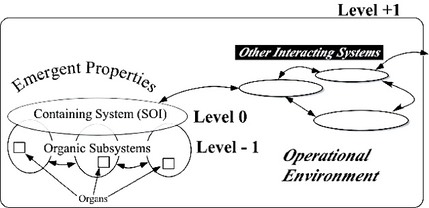FRIDAY, 8 MAY 2009

Analysis Vs. Synthesis. Analysis decomposes, breaks things apart, to gain knowledge about whatever is ‘inside’ something. Break something down into its constituent parts, the argument goes, understand how each of the parts works separately, and then put the explanations together to gain an understanding/explanation of the whole. Seductively simple: and it works for simple things.
So, what is wrong with analysis/reduction. The issue centres on the interactions between the parts/subsystems, which give rise to so-called emergent properties of the whole. Self-awareness is an emergent property of the human brain, for example - and, seemingly from the elephant brain too, to judge by recent experiments.
Emergence is all around us, if we have eyes to see:
- Life can be thought of as ‘emerging’ from DNA - which is an inert, lifeless, chemical molecule.
- Apples ‘emerge’ from apple trees: roses from rose bushes.
- Confidence and team spirit emerge from a winning team.
- Military capability emerges from the right combination of infantry, armour, intelligence, engineers, logistics, transport, etc., where ‘right’ implies ‘appropriate to a particular combat challenge.‘
- Capability is emergent only in a ‘suitable’ context and environment, without which there can be no interactions... no interaction, no emergence, no proven capability
- Beautiful music - even different moods - can emerge from an orchestra, in which the different instruments blend their various contributions under the co-ordinating direction of their conductor, all following–and interpreting–a score.
The difficulty with emergence is that you cannot find its roots using analysis - when you take the parts apart, there is nothing to find. Why not? Because in taking apart, you disconnect the interactions that contribute to the emergent property, capability or behaviour... All of which is “Day One” of any ‘systems’ course.
One popular example puts it this way: A Martian comes to Earth and picks up a watch. He takes the watch apart to see how it works, and he can reassemble it. But none of this helps him to understandthe concept of time...
So, the argument then goes: “If we cannot find emergence by analysis, perhaps we can ‘create’ emergence by synthesis - by choosing the right parts, by bringing them together in the right way, and by ‘orchestrating’ their interactions so that the whole does indeed exhibit emergent properties when performing in its operational environment. That might be a bit tricky, but it should work...”
An aim, then, of systems science, systems thinking, systems design, systems engineering - i.e., of ‘systems’ as a discipline - is to create emergent properties of the whole ‘to order,’ as it were, such that the whole is greater than the sum of its parts in a prescribed and intended way. And at the heart of this creation is synthesis: bringing subsystems together, and causing them to interact in such a way that they create, not only a whole solution, but one which exhibits requisite emergent properties, capabilities and behaviours of the whole when performing in its operational environment.
So, is synthesis difficult? Surprisingly, perhaps, it is not. Viewed from the vantage point of a systems hierarchy, it covers only three hierarchy levels:

In the figure, the system of interest (SOI) is at the left, comprised of several ‘organic’ subsystems, which contain ‘organs,’ or parts. The whole containing system, the SOI, is arbitrarily set at hierarchy level 0 - along with other interacting, sibling, systems - while its contained organic subsystems are at hierarchy Level -1. All the interacting systems at Level 0, including the SOI, exist within a Containing System at Level +1. The Value of the System of Interest may be identified as the degree to which it contributes to its containing system’s objectives, in concert with its siblings. No contribution: no value.
So, there are only three hierarchy ‘levels of interest.’ The organs contained within the organic subsystems are not of direct interest in synthesis, since the actions of organs are subsumed/accounted in the properties of their respective organic subsystems. Synthesis, after all, looks upwards and outwards, into the operational environment. Looking ‘downwards’ into the organic subsystems would be engineering, psychology, disintegration, or analysis, depending upon the type of system.
Of course, we can always shift our focus up or down the hierarchy. We could, for instance, focus on an organic subsystem, setting it at Level 0, such that its operational environment became the sum of the other organic subsystems and interconnections. Then the organs would be at Level -1 and the current SOI in the picture would be promoted to Level +1. In this way, systems folks manage not only the level of detail, but the degree of complexity that they encounter.
So, synthesis can accommodate complexity, can create requisite emergent properties, and so on; why not use synthesis all the time? Well when creating systems we should; however, nearly all of our education is founded in reduction. We are taught to analyse and reduce throughout formal education. So, to be a systems designer, a systems thinker, and a systems engineer, demands that we learn new tricks. It really isn’t “just engineering!”
Indeed, if you follow the argument so far, synthesis is a discipline in its own right, and it works for any and all systems, regardless of kind. So, systems, systems thinking, orthodox systems engineering and synthesis are not really multi-disciplinary as folks would have you believe - instead, they are all of the ‘systems’ discipline, i.e., concerned with wholes. Just because a systems engineer has to talk many different engineering ‘languages,‘that doesn’t make him an engineer, so much as an interpreter! Which may be why so many good systems engineers started out as physicists, operators, geographers, even as archaeologists!
For more on synthesis - central to the Systems Approach - why not go to:
http://www.hitchins.net/Systems_Approach.html#Synthsis ?
Sixty or more years after orthodox systems engineering was developed, and was instrumental in putting Man on the Moon, there has arisen a sham, emasculated version which, unlike the original, the orthodox version, is largely devoid of ‘systems.’
In stark contrast, this cut-down doppelganger depends upon analysis and reduction, the antithesis of synthesis - one of the three cornerstones of orthodox systems engineering. The other two corner stones? Holism and organicism.
Well, you had to ask, now didn’t you?